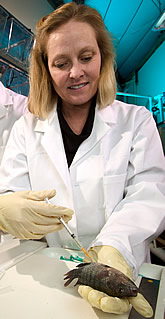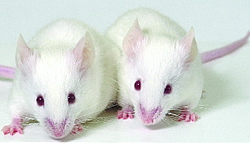This page has been archived and is being provided for reference purposes only. The page is no longer being updated, and therefore, links on the page may be invalid.
ARS Scientists Honored for Transfer of Technology
By Laura McGinnisFebruary 8, 2006
WASHINGTON, Feb. 8—Two Agricultural Research Service (ARS) teams have won the agency's top technology transfer award for developing catfish vaccines and designing a humane lancet for drawing blood from laboratory mice.
"Transferring our research to the marketplace is a key part of the agency's mission," said ARS Administrator Edward B. Knipling. "I want to congratulate all of our scientists for their innovative research and their work enabling these discoveries to benefit us all."
Both teams have received the ARS 2005 Technology Transfer Award for Outstanding Efforts. The award recognizes agency scientists who develop new technology and transfer it to the marketplace. These scientists and others were honored Feb. 7 at a ceremony at USDA headquarters here.
ARS scientists at the Aquatic Animal Health Research Unit in Auburn, Ala., collaborated with animal health company Intervet, Inc., to develop two modified live vaccines for the bacterial diseases enteric septicemia and columnaris. In 2003, nearly 50 percent of all U.S. catfish operations reported problems related to these diseases. The lack of any effective control measure was costing the U.S. catfish industry as much as $70 million a year, according to a USDA study. Since the first vaccine was released in 2001, nearly 1 billion fish have been vaccinated, saving the industry millions of dollars.
Earlier attempts to vaccinate catfish against these diseases used killed vaccines. ARS researchers Craig Shoemaker, Joyce Evans and Phillip Klesius approached the problem from a different angle. They developed modified live vaccines, which proved to be more effective, less expensive, easier to administer and longer-lasting. A week-old fish that receives the vaccines via bath immersion will be protected against both diseases for the rest of its life. In addition to saving the industry money, the vaccines decrease the need for antibiotics and increase yields by improving growth and survival rates. (More about the research)
|
|
Scientists at the Plum Island Animal Disease Center, Greenport, N.Y., developed an improved lancet as a humane way to draw blood from laboratory mice. Collecting blood samples from mice requires patience and practice. Drawing blood from the cheek is the most accurate and comfortable method for the mice, but their small size complicates the procedure, so Plum Island scientists collaborated with medical manufacturer MEDIpoint to create a humane and painless lancet for mice.
The Goldenrod lancet, named for its inventors—William Golde and Luis Rodriguez of ARS and MEDIpoint engineer Peter Gollobin—bypasses the shortcomings of traditional methods. The Goldenrod works like the thumb sticks diabetics use to test their blood sugar levels. It draws four to 10 drops of blood from the mouse, which shows nearly immediate recovery. Following its debut, MEDIpoint sold more than 30,000 of the lancets in the first two weeks and more than 300,000 within the first eight months. The lancet has received praise from the scientific community as a safe, efficient, inexpensive, humane, uncomplicated alternative to traditional bleeding methods. (More about the research)
ARS also recognized six individuals and groups for superior efforts in technology transfer:
- Bruce Wood of the Southeastern Fruit and Tree Nut Research Laboratory in Byron, Ga., developed and commercialized a product to alleviate nickel deficiencies in pecan trees and other crops. The product could increase pecan farmers' gross revenue by about $25 million per year. (More)
- Douglas Light of the Plant Mycotoxins Research Unit in Albany, Calif., and Alan Knight of the Fruit and Vegetable Insect Research Unit in Wapato, Wash., developed technology to improve monitoring and control of the codling moth, a major pest of apple, pear and walnut crops worldwide, and reduce the need for pesticides. (More)
- Stanley Anthony, who has now retired from the Cotton Ginning Research Unit in Stoneville, Miss., developed and commercialized Louvered Lint Cleaner Technology, which allows "prescription" processing and reduces the amount of fiber wasted in the lint-cleaning process without harming fiber quality. This technology is already in use in eight countries, saving about $6 per bale. (More)
- The Near-Infrared Spectroscopy Automated Sorting Technology Team, led by Floyd Dowell of the Manhattan, Kan., Engineering Research Unit, developed near-infrared spectroscopy technology to detect and sort grain based on quality. Their research has also been applied to high-speed sorters of soybeans, corn, millet and sorghum. (More)
- Molly Kretsch, formerly with the Western Human Nutrition Research Center in Davis, Calif., and Alice Fong, formerly with ARS, envisioned and developed the Nutrition Evaluation Scale System, a computerized interactive tool that captures and evaluates food and nutrition information, years before widespread computer literacy guaranteed its success. The system has spawned nutritional evaluation products for professional and consumer use. Kretsch is now an ARS National Program Leader for Human Nutrition. (More)
- The Area-wide Management and Evaluation of Melaleuca Team, led by Paul D. Pratt of the Fort Lauderdale, Fla., Invasive Plant Research Laboratory, promoted the adoption and integration of three biological control insects to control the invasive tree Melaleuca quinquenervia in southern Florida, by demonstrating the ecological and economical sustainability of biological control as an integrated pest management (IPM) technique. (More)
ARS is the U.S. Department of Agriculture's chief scientific research agency.


